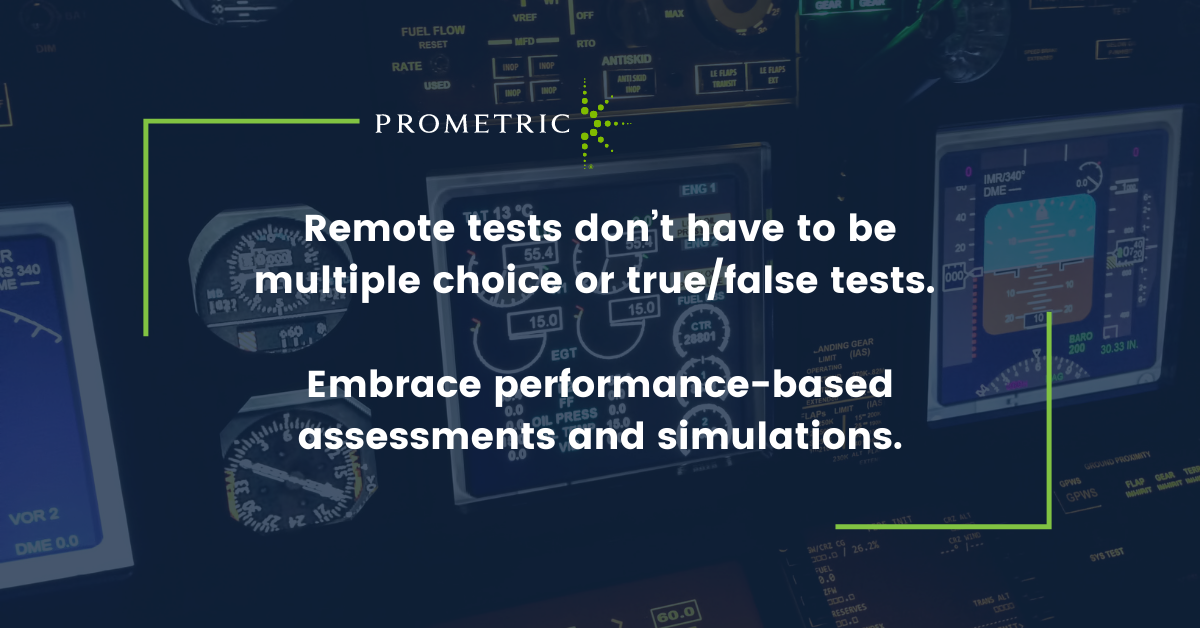High-stakes testing can be anxiety-inducing for many people. No matter how much one prepares for their test, it’s not very often that they feel 100% ready to take it. As the test sponsor, one of the best things you can do to ease your candidate’s anxiety, and furnish them with a testing scenario tailored to promote a successful outcome, is to provide them with an intuitive and thoughtful in-person and remotely proctored exam experience.
The testing experience begins when the exam is scheduled and extends to the point where the candidate gets their results. While proctoring ensures the security of your assessment by preventing issues such as cheating, there’s more to a candidate’s experience than that.
Delivering a successful assessment means considering a variety of factors, including:
Is the exam cost and delivery mode manageable for your test-takers?
Is the scheduling intuitive and flexible?
Are candidates aware of how to complete their exam and where to get their scores?

To take these factors into consideration, here are five ways you can deliver a better testing experience for your candidates:
1. Answer Questions Before Your Candidates Need to Ask Them
Anticipate the candidates’ needs: Once the assessment is scheduled, your test delivery platform should automatically email the test-taker and inform them where to access it, how to log in, and what they need to bring to the test beforehand. If they have to go searching for this information, it increases their chances of missing important details and prevents them from being prepared and comfortable for when their test is set to begin.
The proctoring service you use should send out all the information necessary and may even go the extra mile of preparing an FAQ to answer the most commonly asked questions directly. This saves both you and your candidates time, lets them know what to expect, and instills confidence and trust in your exam process.
2. Provide In-Person and Remote Testing Opportunities
Scheduling time for a major exam can pose a variety of difficulties. If one of your candidates is a parent who can’t access a quiet environment in their home to sit for their virtual exam, how would you help? Or another person who can’t travel to your in-center test because they’re too far away or otherwise engaged in the hours leading up to the test. What happens then?
Anticipate these different circumstances by providing different test delivery options without compromising on the quality of their test. Choose a delivery partner that can help make this happen even where it looks impossible, such as long-duration exams that require focus for long periods of time, or properly administering breaks without hitches.
Consider providing multi-modal test delivery, where tests are delivered both in physical testing centers, as well as remotely for individuals unable to access a test center. In either of these test delivery options, a competitive proctoring solution will be able to provide your candidates with an appropriate environment for taking their test.
3. Prioritize Accessibility
Make your test inclusive by catering to all members of your testing community with a focus on accessibility. Where you offer computer-based testing, ensure that the platform supports assistive technologies such as screen readers, speech input software and screen magnification.
You can also provide pathways for learners who may need additional time or other support during the assessment. For instance, have a virtual proctor on standby to answer any platform-related questions during the test and provide an option for additional time for those test-takers needing additional support to complete the assessment.
Your organization may also consider providing the test in multiple languages to reduce the language barrier. Multiple languages also enables your program to access a global audience, increasing the pool of candidates who can take your test. As you look for proctor partners, consider this option and their ability to provide personalized support for candidates in a range of languages.
4. Provide a Test Drive Opportunity
What will the exam look like? What form will it take? Pre-exam jitters are exacerbated when test-takers are unfamiliar with what their examination could look like. Don’t let this be a burden to your candidates.
Offer them a sample exam that they can use as practice to familiarize themselves with the format of the test. They can learn to navigate the exam portal and test their knowledge while at it. Your sample experience can even include the process for check-in, room scan, familiarization with the test center or online portal, personal item storage, and other details that test-takers will experience on their test day.
5. Make Your Exam an Engaging, Flexible Experience
Remote tests don’t have to be multiple choice or true/false tests! You can diversify the assessment format for greater engagement. Embrace performance-based assessments and simulations, depending on your field. For instance, a digital marketing course could simulate a design tool where candidates design some content for social media using a standard program.
An assessment in architecture could include a 3D modeling simulation to demonstrate the individual’s ability, increasing engagement with the evaluation. And where the candidates have different ability levels, performance-based testing could also gauge competency on a specific platform being assessed, making the experience more friendly.
Final Thoughts
Intuitive Remote Exam Proctoring for Improved Candidate Experience
Whether remote or in-person, your candidates’ testing experiences can be improved by anticipating their needs and giving them a seamless end-to-end experience. By working with a partner like Prometric, you can be a step ahead of the competition, and provide your test-takers with a candidate-focused testing experience that ensures the security and scalability of your program.
Learn more today!